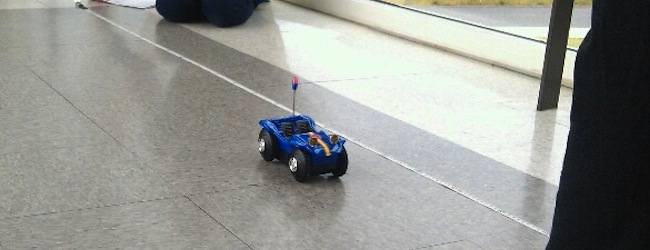
Episode 66 – But Are They Really Learning?

Frank Noschese
This week we discuss teaching techniques with Frank Noschese. Frank is a high school physics teacher at John Jay High School in Cross River, N.Y. and an active blogger. We talk with Frank about blogging, active student engagement, flipped classrooms, psuedoteaching, and the Khan Academy. Join the conversation and leave your comments.
Preview from the Show:
There’s a lot of research and evidence to backup the fact that having a more interactive class does work. And there’s a lot of ways to go about being interactive. One way is with the questioning technique that you were talking about in the Harvard justice videos; I haven’t seen them, but it sounds like that’s one way. Or using clickers is another way. Or with whiteboarding and modeling, where the kids are working in groups on these problems, and they’re working on them on these large whiteboards that maybe two or three kids can work on at a time, and they share and present their solutions to the problem. So there’s lot of different techniques depending on the size of the class and the materials that you have, so I don’t think anybody should just be able to throw their hands up and say “well based on my situation, the only thing I can do is lecture”, because there’s always different techniques.
If you think back to even how you learned – something that you found you had to struggle through, whether it was a sport or an instrument, or a kind of arts and crafts, woodworking – anything like that. You worked hard at it, got feedback from someone who knew what they were doing, there were lots of tests along the way to see if you were getting it or not. That kind of interactivity and feedback is so necessary for learning. And then there’s also people that say – we had this conversation on twitter a few months ago – where somebody said “but kids do learn from lecture, there are kids that are gaining.” And it’s true, there are kids that do still learn physics through lecture, and what we think is going on there is that the kids are doing these active engagement strategies in their head, so they’re trying to think ahead: “what’s the next step this would take”, or “how does this fit in with that,” and they’re doing it in their head. And these are very few kids that actually know how to learn from a lecture, and I would say the bulk of students just sit there and think that they’re going to learn from osmosis.
Links:
- Action-Reaction (Frank’s Blog)
- Frank on MSNBC talking about
- Frank on flipped classrooms with USA Today
- Follow Frank on Twitter
- Frank on the Web: Frank’s Posterous, Noschese 180, Win? Fail? PHYSICS!, WQDYH?
- Harvard’s Justice with Michael Sandel
- A Private Universe
- dy/dan (Dan Meyer)
- Geoset (Global Educational Outreach for Science, Engineering and Technology)
- Veritasium Science Videos
To listen to this episode, download the mp3 directly, find us on iTunes, or use the player below.
Pingback: Interview on NSTA’s Lab Out Loud Podcast | Action-Reaction
I teach chemistry (and sometimes physics) in a blended, flipped classroom. I make all my own videos (which I think is critical for flipping your classroom), and it has been a raging success. For the last two years, I have not even turned on the LCD projector in my room. I almost never talk to the entire group for more than 2 minutes. I know my students better, I get constant feedback from every kid (who’s there) every day. My students’ understanding (yes, I’m assessing it) is up. Performance on everything from daily check quizzes to reports on lab activities is up. Kids are actively engaged all day in making content. Since my classes are asynchronous, kids learn at a pace where they can master the material, not barely grasp it as they struggle to keep up with the group. I will not abandon my flipped classroom because people like Frank Noschese and Richard Haake have villified lecture and decided that vodcasting is the exact same thing as lecture, so therefore flipping a classroom must be horrible pedagogy. Also, I’m not sure why people think that all flipped classrooms are using Sal Khan’s stuff or that all vodcasts are the cheap, boring very lecture-like tabcast material that Sal is putting out.
Frank’s idea of “pseudoteaching” is a smokescreen, in my opinion. It’s a way of giving a bad name to anything Frank doesn’t like. How does any teacher know if the kids are learning? By interaction and feedback, which can be achieved through a variety of pedagogical approaches, including the much maligned lecture format. Good teachers care if their students are learning, and they find ways to interact and gather feedback, even if they are lecturers. Bad teachers don’t care if their students are learning, and they find ways to avoid interaction and feedback (because it’s hard work) even if they are pursuing one of the very fashionable guided inquiry paradigms (which are very good teaching methods, don’t get me wrong).
Interactive learning is very effective, it allows students to learn more from their classmate. Can easily ask questions about something they don’t understand. Also, with the help of technology, teaching jobs are a lot easier for both teacher and students.
Pingback: Lab Out Loud Podcast: But Are They Really Learning? | Teacher Elinks
Pingback: But Are They Really Learning? | contributingeducation